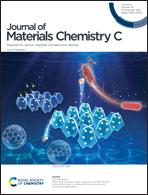High-performance perovskite memristor by integrating a tip-shape contact†
Abstract
Resistive random access memory (RRAM) based on hybrid organic–inorganic halide perovskite (HOIP) materials has recently gained significant interest due to its low activation energy of ion migration. HOIP RRAM has been reported to exhibit outstanding performance, but they still suffer from issues of high operating voltage and poor uniformity. Here, we provide an efficient method for improving the resistive switching characteristics of HOIP RRAM by integrating an Au tip in the bottom electrode to regulate the growth of conductive filaments (CFs). The Ag/polymethylmethacrylate/CH3NH3PbI3/Au tip/indium tin oxide RRAM exhibits a lower set voltage of −0.11 V, a larger ON/OFF ratio of 108, excellent durability (up to 4 × 103 times), low power consumption, and good non-volatility. Moreover, the time-dependent resistive switching characteristics were investigated by a statistical analysis of the data on the turn-on time based on the Weibull distribution. Tests using transmission electron microscopy, electron energy depletion spectroscopy, and energy dispersive spectroscopy have demonstrated that the formation and rupture of CFs occur mainly in the CH3NH3PbI3 layer and that the CFs should be composed of Ag atoms and I vacancies. Our research offers a strategy for enhancing the stability of perovskite devices and promoting the application of low-power, high-density non-volatile memory devices.



 Please wait while we load your content...
Please wait while we load your content...